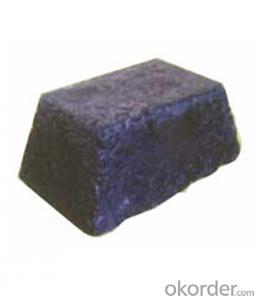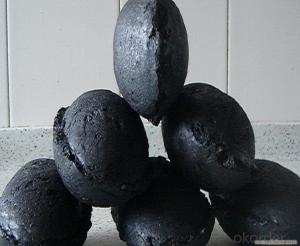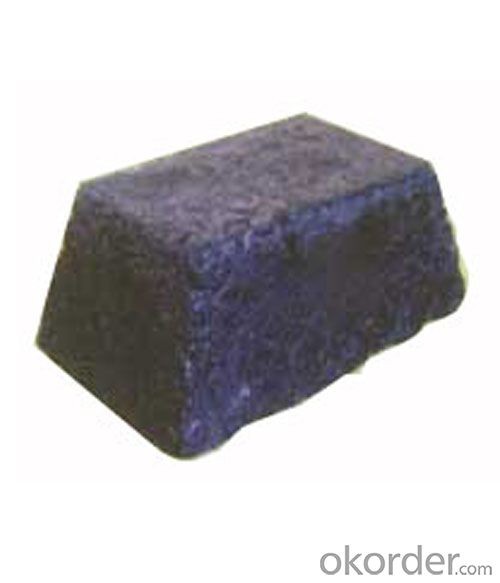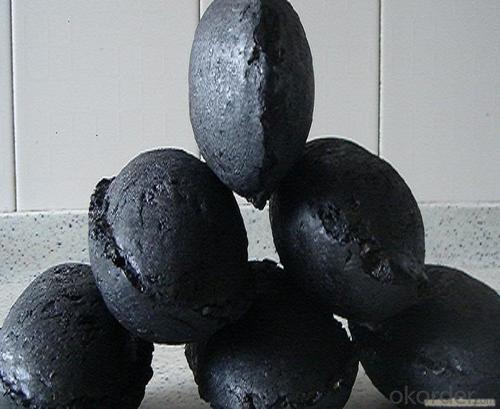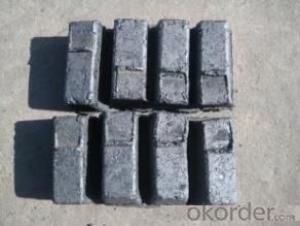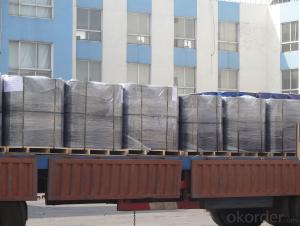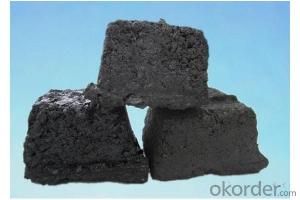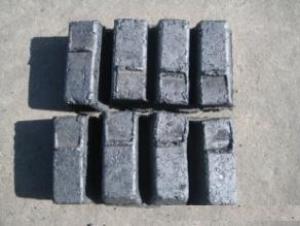Good Quality Carbon Electrode Paste Block
- Loading Port:
- Tianjin
- Payment Terms:
- TT OR LC
- Min Order Qty:
- 0 m.t.
- Supply Capability:
- 20000 m.t./month
OKorder Service Pledge
OKorder Financial Service
You Might Also Like
Carbon Electrode Paste:
•Main Function And Features
1) Low ash content
2) Good electric and thermal conductivity
3) High resistance to temperature
4) Stable quality
5) Reasonable price
6) Size:all kinds of electrode paste
7) Accord customer's reques change
•Introduction To Products
1) Carbon Electrode Paste is a self-baking electrode used in submerged arc furnaces for delivering power to the charge mix.
2) Electrode Paste is added to the top of the electrode column in either cylindrical or briquette form.
3) As the paste moves down the electrode column the temperature increase causes the paste to melt and subsequently bake
forming a block of electrically conductive carbon.
4) Electrode Paste is essentially a mix of Electrically Calcined Anthracite (ECA) or Calcined Petroleum Coke (CPC) with Coal
Tar Pitch.
• Application Range
1) Be used as the electrode for self roasting in the iron-alloy furnace and acetylene furnace.
2) Amorphous graphite powder--applied in steel making,fireproof material,casting coating.
3) Calcined petroleum coke--used in foundry,metallurgy,carbon paste,graphite electrode.
4) Carbon anode scrap--used as smelting fuel for copper smelting industry.
5) Carbon electrode paste--applied in iron alloy,calcium carbide,ferroalloy,ferromanganese.
•Main Technical parameters
Graphite/Carbon Electrode Paste
Specification/Item | |||||||
Ash | max | 4.0%max | 5.0%max | 6.0%max | 7.0% Max | 9.0% Max | 11.0% Max |
VM | % | 12.0%-15.5% | 12.0%-15.5% | 12.0%-15.5% | 9.5.0%-13.5% | 11.5%-15.5% | 11.5%-15.5% |
Compress Strength | Mpa Max | 18.0Mpa Min | 17.0Mpa Min | 15.7Mpa Min | 19.6Mpa Min | 19.6Mpa Min | 19.6Mpa Min |
Specific Resistance |
μΩm Max | 65μΩm Max | 68μΩm Max | 75μΩm Max | 80μΩm Max | 90μΩm Max | 90μΩm Max |
Bulk Density | G/CM3 Min | 1.38G/CM3 Min | 1.38G/CM3 Min | 1.38G/CM3 Min | 1.38G/CM3 Min | 1.38G/CM3 Min | 1.38G/CM3 Min |
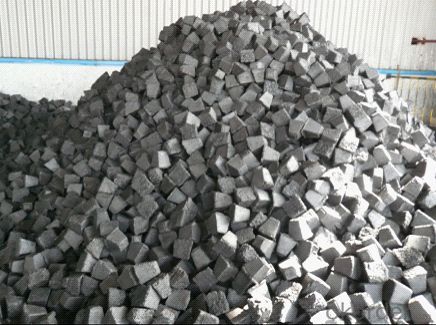
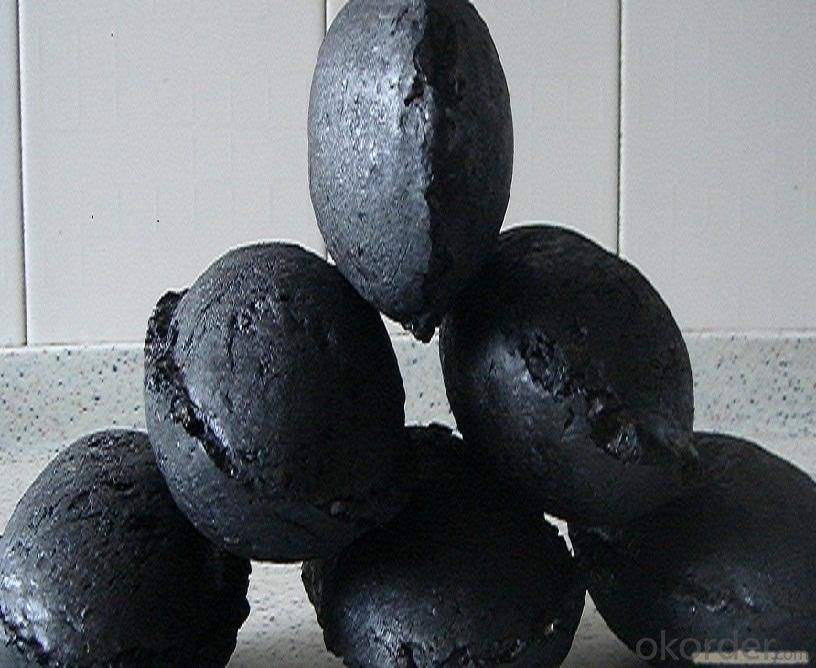
- Q: How does carbon contribute to the structure of DNA?
- The structure of DNA relies heavily on carbon, as it plays a critical role in its composition. Carbon is a crucial element in the formation of the sugar-phosphate backbone, which is an integral part of the DNA molecule. This backbone consists of alternating sugar and phosphate molecules, with the sugar molecule being deoxyribose in DNA. Deoxyribose sugar contains five carbon atoms, making carbon a significant component in its structure. These carbon atoms provide stability and rigidity to the backbone, ensuring the overall structure of the DNA molecule remains intact. Additionally, carbon also contributes to the formation of the nitrogenous bases that form the ladder-like structure of DNA. There are four nitrogenous bases in DNA: adenine (A), guanine (G), cytosine (C), and thymine (T). Carbon atoms are present in the structure of each of these bases, giving them their distinct chemical properties. Various functional groups containing carbon, such as amino and keto groups, actively participate in hydrogen bonding and stacking interactions that determine the base pairing within the DNA double helix. To summarize, carbon is an indispensable element in the structure of DNA. It not only provides stability and rigidity to the sugar-phosphate backbone but also plays a crucial role in the formation of the nitrogenous bases. The unique properties of carbon enable DNA to maintain its double helix structure and facilitate the accurate transmission of genetic information.
- Q: What are the effects of carbon emissions on the stability of volcanic regions?
- Carbon emissions can potentially have both positive and negative effects on the stability of volcanic regions. On one hand, increased carbon dioxide levels in the atmosphere can contribute to global warming, which in turn may lead to melting of glaciers and ice caps, resulting in a rise in sea level. This rise in sea level can increase the likelihood of volcanic flank collapse, as the added pressure weakens the stability of volcanic slopes. Additionally, global warming can also trigger more frequent and intense rainfall, potentially leading to increased erosion and landslides in volcanic areas. On the other hand, carbon dioxide emissions can also have a stabilizing effect on volcanic regions. The injection of carbon dioxide into volcanic systems can enhance the pressure within magma chambers, promoting magma crystallization and solidification. This process can reduce the likelihood of volcanic eruptions, as the solidified magma acts as a barrier that hinders the movement and release of magma. Overall, the effects of carbon emissions on the stability of volcanic regions are complex and dependent on various factors. It is crucial to continue studying these interactions to better understand the potential consequences and implications for volcanic hazards and the overall stability of volcanic regions.
- Q: What is the role of carbon in the formation of diamonds?
- The role of carbon in the formation of diamonds is essential, as diamonds are composed entirely of carbon atoms arranged in a crystal lattice structure. The extreme heat and pressure deep within the Earth's mantle cause carbon atoms to bond tightly together, forming the unique structure of a diamond. Without carbon, diamonds would not exist.
- Q: How does carbon pricing work?
- Carbon pricing is an approach that utilizes the market to decrease greenhouse gas emissions by placing a value on carbon emissions. This is achieved by assigning a financial cost to the release of carbon dioxide and other greenhouse gases into the atmosphere, which greatly contribute to climate change. There exist two primary forms of carbon pricing mechanisms: carbon taxes and cap-and-trade systems. Under a carbon tax, a fixed price per metric ton of carbon emissions is established, and emitters are obligated to pay this tax according to their emissions. The tax can be imposed at different points in the supply chain, such as during extraction, production, or consumption. The goal of a carbon tax is to create a economic deterrent for emitting carbon and motivate industries and individuals to reduce their emissions. On the other hand, cap-and-trade systems impose a limit or cap on the total amount of carbon emissions permitted within a specific jurisdiction. This cap is divided into allowances, which represent the right to emit a particular amount of carbon. These allowances are either distributed or auctioned to emitters in the form of permits. Emitters can then trade these permits amongst themselves in a market. If an emitter surpasses their allocated allowances, they must purchase additional permits from those who have surplus allowances. This establishes a market-based incentive for emission reduction, as those who can more cost-effectively decrease their emissions can sell their excess allowances to those who are unable to. Both carbon taxes and cap-and-trade systems aim to incorporate the cost of carbon emissions into the economy, making pollution more expensive and encouraging the adoption of cleaner technologies and practices. By assigning a value to carbon, these mechanisms provide economic signals that urge businesses, industries, and individuals to invest in low-carbon alternatives, energy efficiency, and innovation. Additionally, they generate revenue for governments, which can be utilized to fund efforts in climate change mitigation and adaptation, renewable energy projects, or to reduce other taxes. Overall, carbon pricing mechanisms are designed to establish economic incentives for reducing greenhouse gas emissions, facilitating the transition to a low-carbon economy, and mitigating climate change. While they may not be a perfect solution, they are widely acknowledged as one of the most effective tools for driving emission reductions and combating climate change.
- Q: Buy carbon carving, how to identify him is true or false, and the quality of good or bad?
- Most consumers think the difference between "Zijin carbon carving" and activated carbon is a cheap, a noble, a beautiful, a dirty, in fact they have a completely different function, "Zijin carbon carving at least three point is beyond the powder activated carbon.One is "up to 100 times longer and even thousands of times the Zijin carbon carving" activated carbon powder than life, there is a gap between the granular activated carbon powder, the gap will be preferential adsorption of water vapor, in one to two months (the South may be less than half a month) to form a hydrophilic outer shell thus, lost its adsorption function, and the "Zijin carbon carving" the large volume high fine carbon, molecular absorption pressure technology of gapless combined, and through the fine carbon activation activation of the "Zijin carbon carving" internal logic array pore formation, through carbonization and activation, pore forming process makes "Zijin carbon carving" to achieve through the hole directional adsorption of formaldehyde, benzene and other toxic and harmful gases but also through the large hole directional water vapor, but also through the hole directional adsorption of radiation, thereby greatly prolonging the service life.Second is the powder activated carbon particles easily suspended in the indoor air, forming second pollution, and "Purple carbon carving" seamless seamless activated carbon sublimation products, no pollution second times.Third, "Purple carbon carving" has an elegant artistic form. It is an ideal decoration for home and office, and the purification effect is more thorough
- Q: How does carbon affect air quality?
- Carbon is a major contributor to air pollution as it combines with oxygen to form carbon dioxide (CO2), a greenhouse gas responsible for climate change. Additionally, carbon-based pollutants, such as carbon monoxide (CO) and volatile organic compounds (VOCs), can be released from the combustion of fossil fuels and contribute to poor air quality and negative health effects.
- Q: How does carbon impact ocean acidity?
- Carbon impacts ocean acidity through a process called ocean acidification. When carbon dioxide (CO2) from the atmosphere is absorbed by seawater, it reacts with water molecules to form carbonic acid. This acidification process lowers the pH levels of the ocean, making it more acidic. The primary source of carbon dioxide in the atmosphere is human activities such as burning fossil fuels, deforestation, and industrial processes. As the concentration of CO2 increases in the atmosphere due to these activities, more and more of it is absorbed by the oceans. The increase in acidity has several detrimental effects on marine life. Many organisms that have calcium carbonate shells, such as coral reefs, shellfish, and some plankton species, are particularly vulnerable to ocean acidification. The increased acidity makes it harder for these organisms to build and maintain their shells, leading to reduced growth rates and increased mortality. Ocean acidification also affects the entire marine food web. It disrupts the balance between predators and prey, as some species of plankton are less able to develop and survive in acidic conditions. This can have cascading effects on the entire ecosystem, impacting fish populations, marine mammals, and ultimately even humans who rely on seafood for sustenance. Additionally, ocean acidification can have significant economic impacts. Commercial fisheries and tourism industries that depend on healthy marine ecosystems can suffer due to the decline in fish populations and the degradation of coral reefs. To mitigate the impacts of carbon on ocean acidity, it is crucial to reduce carbon dioxide emissions and transition to cleaner and more sustainable energy sources. Taking steps to protect and restore marine ecosystems, such as creating marine protected areas and implementing sustainable fishing practices, can also help to mitigate the effects of ocean acidification.
- Q: What is carbon nanomembrane?
- Carbon nanomembrane is a thin, flexible sheet made up of carbon atoms arranged in a precise pattern. It has unique properties such as high strength, electrical conductivity, and impermeability, making it suitable for various applications like filtration, energy storage, and biomedical devices.
- Q: What is carbon fiber and how is it used?
- Made from thin strands of carbon atoms bonded together in a specific pattern, carbon fiber is a material that is both lightweight and incredibly strong. Its exceptional strength-to-weight ratio surpasses that of steel, while its weight is significantly lighter. The unique properties of carbon fiber make it widely used across various industries and applications. In the aerospace industry, it is a common choice for constructing aircraft components such as wings, fuselage sections, and engine parts. Its strength and lightness contribute to better fuel efficiency and overall performance. The automotive industry heavily relies on carbon fiber for manufacturing high-performance vehicles. Carbon fiber reinforced composites are utilized in the production of body panels, chassis components, and interior trims. By reducing the overall weight of vehicles, carbon fiber not only enhances structural integrity but also improves handling and fuel efficiency. Sports equipment manufacturers also incorporate carbon fiber into the production of sporting goods like tennis rackets, golf clubs, bicycles, and hockey sticks. The material's strength and stiffness result in improved performance, increased power transfer, and enhanced durability. Additionally, carbon fiber finds applications in the construction industry for reinforcing concrete structures, as well as in the manufacturing of wind turbine blades, boat hulls, and various other industrial components. Overall, carbon fiber is the preferred choice in industries requiring high-performance materials due to its exceptional strength, lightweight nature, and versatility. As advancements in manufacturing techniques and cost reduction efforts continue, its use is expanding to a wider range of applications.
- Q: How does carbon affect ocean acidification?
- Various human activities, such as burning fossil fuels and deforestation, release carbon dioxide (CO2) into the atmosphere. This CO2 is a greenhouse gas that, when absorbed by the oceans, leads to a process called ocean acidification. When CO2 dissolves in seawater, it reacts with water molecules and forms carbonic acid. This reaction increases the concentration of hydrogen ions (H+), resulting in a decrease in pH levels and making the seawater more acidic. This decrease in pH is a key characteristic of ocean acidification. As the ocean becomes more acidic, it disrupts the delicate chemical balance that many marine organisms rely on for survival and growth. Organisms like corals, shellfish, and phytoplankton use calcium carbonate to build their shells or skeletons, but increased acidity hampers their ability to do so. Ocean acidification also impacts the growth and development of marine plants and animals. For instance, changes in pH levels can affect the ability of larvae from certain marine species to form strong shells or skeletons. Additionally, acidified waters can disrupt the metabolism and reproductive processes of many marine organisms. The consequences of ocean acidification extend beyond individual organisms. Entire ecosystems, such as coral reefs, face threats due to increasing acidity. Coral reefs provide habitat for numerous species and are vital to marine biodiversity. However, the more acidic conditions make it challenging for corals to build and maintain their calcium carbonate structures, resulting in coral bleaching and degradation of reef systems. Moreover, ocean acidification can have cascading effects on other marine organisms and food webs. For example, changes in the growth and survival rates of phytoplankton, a primary food source for many marine species, can disrupt the entire food chain, impacting fish populations and ultimately affecting human communities that rely on seafood for sustenance and livelihoods. In conclusion, the rise in carbon dioxide emissions contributes to ocean acidification, which alters the chemistry of the oceans and poses significant threats to marine life and ecosystems. Understanding and addressing the causes and impacts of ocean acidification are essential for the long-term health and sustainability of our oceans.
Send your message to us
Good Quality Carbon Electrode Paste Block
- Loading Port:
- Tianjin
- Payment Terms:
- TT OR LC
- Min Order Qty:
- 0 m.t.
- Supply Capability:
- 20000 m.t./month
OKorder Service Pledge
OKorder Financial Service
Similar products
Hot products
Hot Searches
Related keywords
